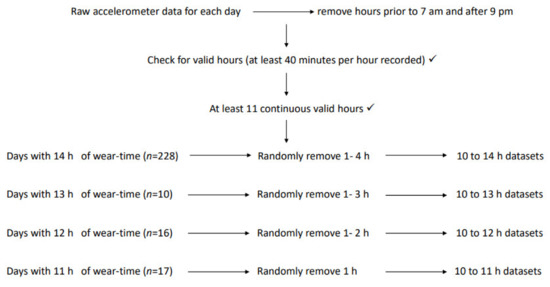I would suggest having them wear accelerometers instead, that way you can get objective measurements of the movement for analysis and correction along with just basic movement time. Now how do we get that suggestion to stroke leadership so research can be improved?
How Many Hours of Device Wear Time Are Required to Accurately Measure Physical Activity Post Stroke?
1
Physiotherapy Department, Alfred Health, Melbourne 3004, Australia
2
Physiotherapy Department, The University of Melbourne, Parkville 3010, Australia
3
Respiratory Research@Alfred, Central Clinical School, Monash University, Melbourne 3004, Australia
4
Stroke Division, Florey Institute of Neurosciences and Mental Health, Heidelberg 3084, Australia
*
Author to whom correspondence should be addressed.
Academic Editor: Veronica Cimolin
Int. J. Environ. Res. Public Health 2022, 19(3), 1191; https://doi.org/10.3390/ijerph19031191
Received: 25 November 2021
/
Revised: 17 January 2022
/
Accepted: 17 January 2022
/
Published: 21 January 2022
(This article belongs to the Special Issue Assessment
and Management of Lifestyle-Related Risk Factors for the Prevention and
Management of Non-communicable Disease in Primary and Community Care)
Background.
Inadequate physical activity participation is a risk factor
for secondary stroke. Before implementing appropriate management
strategies, we need to accurately measure the physical activity of
stroke survivors. We aimed to determine the duration of physical
activity monitoring post-stroke that constitutes a valid day.
Methods.
We sampled stroke survivors’ physical activity for one week following
discharge from inpatient rehabilitation using the Sensewear Armband
(Bodymedia, Pittsburgh, PA, USA). To determine the impact of total daily
wear time on activity estimate (sedentary, light, and moderate to
vigorous physical activity) accuracy, we performed simulations, removing
one, two, three, or four hours from a 14-h reference day, and analysed
them with linear mixed models.
Results.
Sixty-nine participants (46
male, 65 ± 15 years) with 271 days of physical activity data were
included. All physical activity variables were significantly
underestimated for all data sets (10, 11, 12, or 13 h) compared to the
14-h reference data set. The number of days classified as not meeting
physical activity recommendations increased as daily monitoring duration
decreased: 13% misclassification with 10-h compared to 14-h dataset (p
= 0.011).
Conclusions.
The accuracy of physical activity estimates
increases with longer daily monitoring periods following stroke, and
researchers should aim to monitor post-stroke physical activity for 14
daytime hours.
View Full-Text
Keywords:
physical activity; stroke; measurement; wear time; activity monitoring
▼
Show Figures
This is an open access article distributed under the Creative Commons Attribution License which permits unrestricted use, distribution, and reproduction in any medium, provided the original work is properly cited
- Supplementary File 1:
Supplementary (ZIP, 72 KiB)




No comments:
Post a Comment